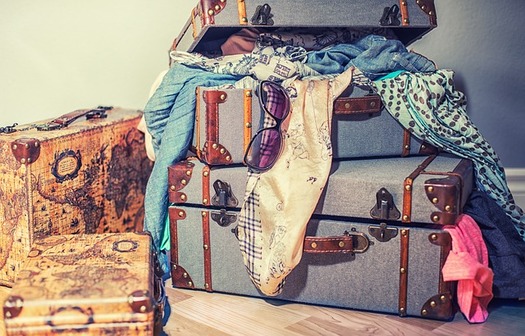
Vintage luggage has a timeless charm that takes us back to a bygone era of travel. Whether you have found a treasure in a thrift store or inherited a piece of history, maintaining the beauty and functionality of your vintage luggage is crucial. In this comprehensive guide, we will reveal the secrets to keeping these timeless travel companions in good condition so they can continue to tell tales of adventures past.
Traveling with vintage luggage is like stepping into a story full of memories from the past; every blemish, scuff, and sticker has a story to tell, which makes these items not only useful but also sentimental. To help you on your journey of maintaining your vintage luggage, we will walk you through seven sections that each reveal a little bit more information than the last, from understanding the materials to dealing with stains and smells, this guide will arm you with the knowledge you need to preserve and rejuvenate your beloved travel companions.
See also our post on A Complete Guide on How to Clean and Maintain Your Vinyl Tile Flooring
Understand Your Vintage Luggage
Know Your Materials
Different vintage luggage pieces are crafted from diverse materials such as leather, canvas, or hardshell plastics. Understand the specific material of your luggage to tailor your cleaning and care approach accordingly.
Identify Weak Points
Examine your vintage luggage for vulnerable areas, such as worn-out corners, weakened stitching, or damaged hardware. Identifying these weak points helps prioritize care efforts and prevent further deterioration.
Recognize Unique Features
Vintage luggage often boasts unique features like hand-stitched details, distinctive hardware, or custom linings. Familiarize yourself with these characteristics to preserve the luggage’s authenticity and charm.
Check for Labels or Tags
Inspect your vintage luggage for labels or tags that provide information about its origin, care instructions, and any special considerations. This information can guide your cleaning and care routine.
Assess Interior Conditions
Examine the interior of your vintage luggage for signs of mold, mildew, or musty odors. Understanding the interior conditions is crucial for comprehensive care, ensuring both the inside and outside remain in pristine condition.
General Cleaning Techniques
Gentle Surface Cleaning
Use a soft, damp cloth to gently clean the surface of your vintage luggage. For stubborn stains, opt for a mild soap or leather cleaner suitable for the specific material. Avoid harsh chemicals that may damage the vintage patina.
Removing Dust and Debris
Regularly remove dust and debris by gently brushing the luggage with a soft-bristled brush. Pay attention to seams, crevices, and corners where dirt tends to accumulate. This simple practice prevents the build-up of grime over time.
Leather Conditioning
For leather vintage luggage, apply a high-quality leather conditioner to maintain its suppleness and prevent cracks. Use a soft cloth to evenly distribute the conditioner, focusing on areas prone to dryness, such as handles and corners.
Canvas Care
Canvas vintage luggage requires special attention. Clean canvas surfaces with a mixture of mild soap and water, using a soft brush for stubborn stains. Allow the luggage to air dry completely to prevent mold growth.
Metal Hardware Polishing
To restore the shine of metal hardware, use a mild metal polish or a mixture of baking soda and water. Gently rub the polish onto the hardware with a soft cloth, then wipe away any residue to reveal the luggage’s original luster.
Stain and Odor Removal Tips
Addressing Stains
Tackle stains promptly to prevent permanent damage. Blot stains on fabric surfaces with a clean cloth and mild detergent. For leather, consult a professional cleaner to ensure the stain is treated without compromising the material.
Dealing with Mold and Mildew
If your vintage luggage harbors mold or mildew, create a mixture of white vinegar and water. Dab the affected areas with a soft cloth soaked in this solution, then let the luggage air dry thoroughly. Repeat if necessary to eliminate lingering odors.
Odor Absorption
Combat musty odors by placing odor-absorbing materials inside the luggage, such as activated charcoal, baking soda, or cedar sachets. These natural absorbers help neutralize odors and maintain a fresh-smelling interior.
Sunlight Exposure
Expose your vintage luggage to sunlight for short periods to naturally eliminate odors and discourage mold growth. Ensure proper ventilation during this process, and avoid prolonged exposure to prevent fading or damage.
Interior Refresh
For fabric-lined interiors, use a fabric freshener or a mixture of water and a few drops of essential oil to refresh the lining. Spritz the solution lightly, and allow the interior to air out thoroughly.
Storage Practices
Climate Control
Store your vintage luggage in a cool, dry place to prevent mold, mildew, and material deterioration. Avoid extreme temperature fluctuations and humidity, as these conditions can negatively impact the integrity of the luggage.
Elevate from Floors
Keep your vintage luggage elevated from the floor by using shelves or protective covers. This prevents direct contact with potentially damp or dirty surfaces, safeguarding the bottom of the luggage from damage.
Use Dust Covers
Consider using dust covers or breathable fabric bags to protect your vintage luggage during storage. These covers shield the luggage from dust and sunlight while allowing air circulation to prevent musty odors.
Rotate and Inspect
Periodically rotate and inspect your stored vintage luggage to ensure even exposure to air and light. This practice also allows you to identify any potential issues, such as pests or deterioration, before they become severe.
Avoid Plastic Wrapping
Avoid wrapping your vintage luggage in plastic, as it can trap moisture and lead to mold growth. Opt for breathable materials that provide protection without compromising the luggage’s condition.
Tips for Repair and Restoration
Professional Assessment
If your vintage luggage requires significant repairs or restoration, seek the expertise of professionals. Consult with a skilled artisan or restoration specialist who can assess the extent of the damage and recommend appropriate interventions.
Stitching and Seam Repairs
Address loose stitching or damaged seams promptly to prevent further deterioration. Use a strong, matching thread for repairs or consult a professional if the damage is extensive. Reinforcing seams ensures the structural integrity of your vintage luggage.
Leather Restoration
For leather vintage luggage, consult a leather specialist for restoration services. Professionals can repair scratches, cracks, or discoloration while preserving the unique patina that adds character to your cherished piece.
Hardware Replacement
If hardware components are damaged or missing, consider replacing them with authentic or carefully matched replacements. This meticulous approach maintains the original aesthetic appeal of your vintage luggage.
Protective Coatings
Apply protective coatings, such as fabric sprays or leather protectors, to shield your vintage luggage from environmental elements. These coatings create a barrier against stains, water, and UV rays, extending the lifespan of your cherished pieces.
How to Travel With Vintage Luggage
Choose Appropriate Use
While vintage luggage exudes charm, consider its condition and the nature of your travels before selecting it for use. Opt for sturdier pieces for extended trips, reserving more delicate items for shorter excursions or display purposes.
Reinforce Weak Points
Before embarking on a journey, reinforce any identified weak points in your vintage luggage. This preemptive measure ensures that the luggage can withstand the rigors of travel without sustaining additional damage.
Packing Sensibly
When packing, use soft garment bags or packing cubes to protect the interior of your vintage luggage. Place heavier items at the bottom and fill empty spaces with soft items to maintain the luggage’s shape and prevent unnecessary strain.
Secure Zippers and Fastenings
Check and secure zippers, clasps, and fastenings before traveling to avoid damage during transit. Taking these precautions ensures that your vintage luggage remains functional and retains its aesthetic appeal throughout your journey.
Monitor Environmental Exposure
Be mindful of environmental exposure during travel. Avoid leaving your vintage luggage in direct sunlight or harsh weather conditions, and store it in a protective cover when not in use to prevent scratches or scuffs.
How to Embrace the Patina
Appreciate the Patina
Embrace the natural patina that develops on your vintage luggage over time. This unique aging process adds character and tells the story of the luggage’s journey. Allow your pieces to age gracefully, celebrating the beauty of their individual histories.
Preserve Original Features
When cleaning and caring for your vintage luggage, aim to preserve original features, such as logos, labels, or unique embellishments. These details contribute to the authenticity and value of your cherished pieces.
Rotate Display
If you use your vintage luggage for display, periodically rotate the pieces to prevent uneven fading from prolonged exposure to sunlight. This simple practice ensures that each piece retains its vibrant colors and original allure.
Avoid Over-Restoration
Resist the temptation to over-restore your vintage luggage. While maintenance is crucial, excessive restoration efforts can compromise the authenticity and charm of your pieces. Embrace imperfections as part of the luggage’s rich history.
Share Stories
Share the stories behind your vintage luggage pieces with others. Whether it’s a family heirloom or a unique find, these narratives contribute to the legacy of your luggage. Encourage appreciation for vintage craftsmanship and design.
See also our post on Janitorial Services: Essential Cleaning for Commercial Spaces
Conclusion
Ultimately, cleaning and maintaining your vintage luggage is more than just keeping it in good condition—it is an adventure in preserving and appreciating the artistry of bygone eras. You can guarantee that your treasured possessions will endure by getting to know them, using mild cleaning methods, taking care of stains and smells, establishing safe storage habits, and being aware of when and where to travel. Repair and restoration, in addition to embracing the patina, enhance the narrative that each piece of vintage luggage tells. Ultimately, cleaning and maintaining your vintage luggage is more than just keeping it in good condition.







